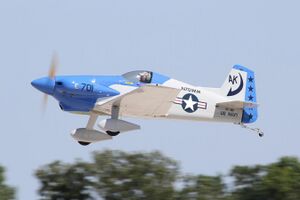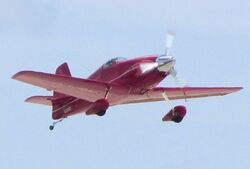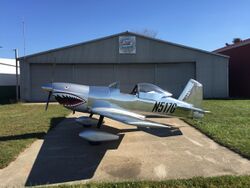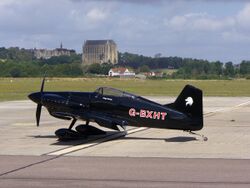Engineering:Mustang Aeronautics Midget Mustang
| Midget Mustang | |
|---|---|

| |
| MM-1 | |
| Role | Aerobatic sports plane |
| Manufacturer | Mustang Aeronautics for Homebuilding |
| Designer | David Long |
| First flight | 1948 |
| Status | In production (2015) |
| Number built | 435 (2011)[1] |
The Mustang Aeronautics Midget Mustang MM-1 is a single-seat aerobatic sports airplane developed and marketed in the United States for homebuilding.[1][2] It is also known as the Long Midget. It was the predecessor to the Mustang II which is also known as the Bushby Mustang. Rights to both the Midget Mustang and the Mustang II were sold to Mustang Aeronautics in 1992.[3]
Development
It is a low-wing cantilever monoplane of metal construction, primarily of 2024-T3 aluminum and most are fitted with fixed tailwheel undercarriage. Developed by Piper engineer David Long in 1948, plans for production by Schweizer were underway at the time of Long's death two years later. All rights and tooling were purchased by Robert Bushby in 1959, who built a 90 hp Continental powered example and sold plans and kits until 1992 [4] when the rights were sold to Mustang Aeronautics. The Midget Mustang design being marketed in 2016 is similar to the original, with the option of building it with a bubble canopy in place of the straight line of the upper tailcone and hinged canopy of Long's original design, making it an M-IA.[5]
Construction requires about 1000 hours of builder time.[6][7][8]
Operational history
The Midget Mustang was intended for air racing. David Long designed an aircraft for a friend to be used in the Cleveland Air Race in 1948. That aircraft was built by Long and was named "Pea Shooter". The Midget Mustang was only moderately successful as a race plane. However, its appearance and desirable flight characteristics made it an ideal sport plane. At the Cleveland Race, racers competed in aircraft with names like, "Mammy","Miss Fort Worth", and "Slo Poke". Over time, air racers modified the aircraft to reach 181 mph (291 km/h) speeds in competition.[9] Nowadays, the Midget Mustang can cruise at 240 mph.
Variants
- Midget Mustang
- "GG"
- A tricycle gear modification[10]
- Graham Super Midget
- Features a manually retracted landing gear.[11]
Specifications (MM-1-125)
Data from Jane's All The World's Aircraft 1982–83[12]
General characteristics
- Crew: One pilot
- Length: 16 ft 5 in (5.00 m)
- Wingspan: 18 ft 6 in (5.64 m)
- Height: 4 ft 6 in (1.37 m)
- Wing area: 68 sq ft (6.32 m2)
- Empty weight: 590 lb (268 kg)
- Gross weight: 900 lb (408 kg)
- Powerplant: 1 × Lycoming O-290-D2 , 135 hp (101 kW)
Performance
- Maximum speed: 225 mph (362 km/h, 196 kn)
- Cruise speed: 165 mph (265 km/h, 143 kn) [13]
- Range: 375 mi (603 km, 326 nmi)
- Service ceiling: 19,000 ft (5,790 m)
- Rate of climb: 2,200 ft/min (11.2 m/s)
See also
Aircraft of comparable role, configuration and era
References
- ↑ 1.0 1.1 Vandermeullen, Richard: 2012 Kit Aircraft Buyer's Guide, Kitplanes, Volume 28, Number 12, December 2011, page 62. Belvoir Publications. ISSN 0891-1851
- ↑ Air Trails: 78. Winter 1971.
- ↑ "Mustang Aeronautics - About". Manufacturer's web site. http://www.mustangaero.com/M_Aero/MustAeroInc.html. Retrieved 2015-08-22.
- ↑ "EAA Fly-In". Flying Magazine: 36. November 1960.
- ↑ "Midget Mustang". Manufacturer's web site. http://mustangaero.com/Midget%20Mustang/Midget%20Mustang.html. Retrieved 2016-05-02.
- ↑ Bayerl, Robby; Martin Berkemeier; et al: World Directory of Leisure Aviation 2011-12, page 112. WDLA UK, Lancaster UK, 2011. ISSN 1368-485X
- ↑ Tacke, Willi; Marino Boric; et al: World Directory of Light Aviation 2015-16, page 119. Flying Pages Europe SARL, 2015. ISSN 1368-485X
- ↑ "M-I FAQs". Manufacturer's web site. http://mustangaero.com/Midget%20Mustang/FAQs/FAQ_BuildTime.html. Retrieved 2016-05-02.
- ↑ Don Berliner (July 1959). "PROFESSIONAL RACE PILOTS ASSOCIATION RACING ALBUM The Long Midgets". Sport Aviation.
- ↑ Air Trails: 11. Summer 1971.
- ↑ Air Progress Sport Aircraft: 72. Winter 1969.
- ↑ Taylor 1982, pp. 532–533.
- ↑ econ cruise
- Taylor, John W. R. (1982). Jane's All The World's Aircraft 1982–83. London: Jane's Yearbooks. ISBN 0-7106-0748-2.
- Taylor, Michael J. H. (1989). Jane's Encyclopedia of Aviation. London: Studio Editions. pp. 225.
- Jane's All the World's Aircraft 1977-78. London: Jane's Yearbooks. pp. 530.
External links
 |




